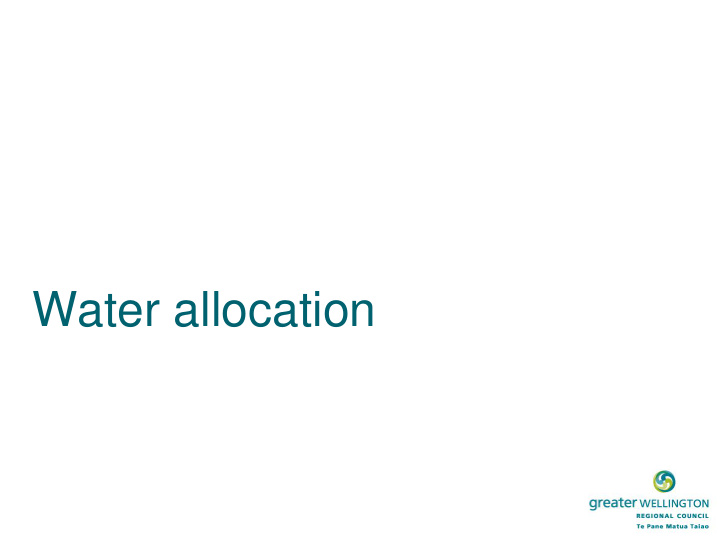



Water allocation
Order of presentations • Paula Hammond - planning context for bores and dewatering • Doug Mzila – expert evidence related to bores and dewatering • Paula Hammond – planning context for water allocation • Brydon Hughes – expert evidence related to the form and content of the conjunctive management framework • Kristina Carrick – resource consent processing perspective • Mark Gyopari – expert evidence related to the conjunctive management framework • Mike Thompson – expert evidence related to minimum flows and allocation
Bores and dewatering
RMA - definitions Water means water in all its physical forms whether flowing or not and whether over or under the ground Includes fresh water, coastal water, and geothermal water Does not include water in any form while in any pipe, tank, or cistern
RMA Part 3 – duties and restrictions Section 9 – use of land outside CMA – permissive Section 12 – use of CMA - restrictive Section 14 – take, use, dam or divert water - restrictive Section 15 – discharge of contaminants to land or water - restrictive
Regional council functions Section 30(1)(c) of RMA – control the use of land for: • Maintaining and enhancing water quality (s30(1)(c)(ii)) • Maintaining water quantity in water bodies and coastal water (s30(1)(c)(iii) Section 30 (1)(d) CMA – control of land & discharges of contaminants Section 30 (1)(f) Control of discharges of contaminants to land and water
Plan objectives – relevant to aquifers, bores and dewatering Objective 5 - Fresh water bodies and the coastal marine area, as a minimum, are managed to: – safeguard aquatic ecosystem health and mahinga kai , and – provide for contact recreation and Māori customary use , and – in the case of fresh water, provide for the health needs of people . Objective O6 - Sufficient water of a suitable quality is available for the health needs of people . Objective O7 - Fresh water is available in quantities and is of a suitable quality for the reasonable needs of livestock . Objective O12 - The social, economic, cultural and environmental benefits of regionally significant infrastructure and renewable energy generation activities are recognised.
Interpretation Aquifer - A geological formation through which water moves under natural conditions and is capable of yielding water at a sufficient rate to be a practical source of water Bore - A structure or hole in the ground constructed for the purpose of: – investigating or monitoring the conditions below the ground surface, or – abstracting liquid substances from the ground, or – discharging liquid substances into the ground. Geotechnical investigation bore – any bore constructed to provide information about soil, sediment or rock Dewatering - The abstraction of groundwater so as to lower the water table for the period of time required to enable maintenance, excavation, construction, or geotechnical work to proceed in the dewatered area, or to sustain a lower localised water table.
Policies Policy P121: Preventing salt water intrusion Taking groundwater shall avoid salt water intrusion into an aquifer Policy P123: Direct, cumulative adverse effects Adverse effects of taking groundwater on the reliability of supply to existing bores shall be minimised. Policy P125: Taking of groundwater The taking of groundwater shall not result in cross-contamination between aquifers or water-bearing layers that results in, or may result in, adverse effects on water quality. Policy P126: Site dewatering Localised land subsidence or adverse effects of dewatering on existing groundwater users and flows, levels and quality of surface water shall be minimised.
Policies Policy P127: Backflow of contaminants There shall be no backflow to surface water or groundwater of contaminants Policy P130: Bores Bores , including new bores , shall: – be sited appropriately – be constructed, the NZS 4411:2001 Environmental Standard for Drilling of Soil and Rock , and – be used in a manner that prevents contaminants entering the bore and the waste of water Policy P131: Bores no longer required Bores decommissioned in general accordance with the NZS 4411:2001 Environmental Standard for Drilling of Soil and Rock .
Rules - Bores Rule R146: Geotechnical investigation bores – permitted activity Rule R147: Drilling, construction or alteration of any bore – controlled activity Rule R148: Drilling, construction or alteration of any bore – discretionary activity Rule R139: Pumping test – permitted activity
Rules - Dewatering Rule R140: Dewatering – permitted activity Rule R142: All other take and use – discretionary activity
Matters in contention or requiring clarification Bores • Rule R147 activity status • Drilling/piling activity in commercial port area Dewatering • Timeframe for dewatering in permitted rule • Dewatering associated with RSI • Cascade to discretionary from permitted • Reference to Rule R42
Recommend
More recommend